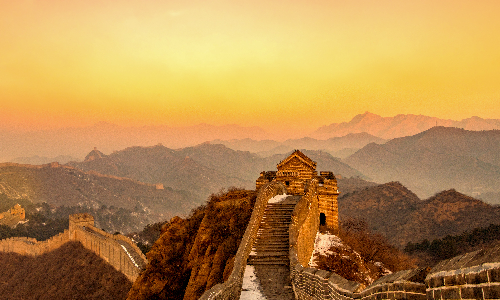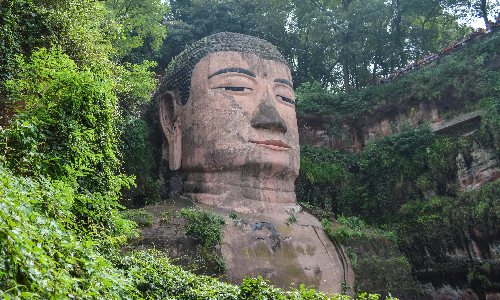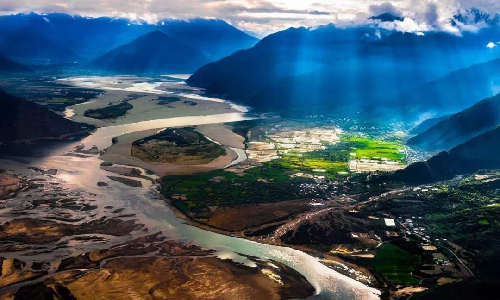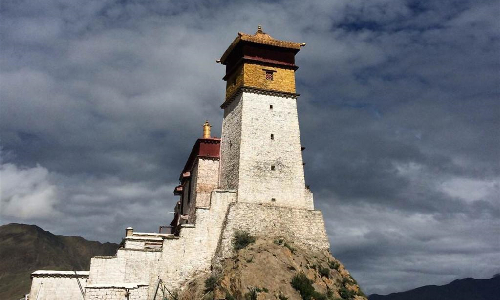Interested in the historical side of China but also looking forward to see something new? This 12-days tour from Beijing is perfect for you. You will start from the capital of China-Beijing, which will present both the new and old China to you. You will visit the world-famous ancient Beijing Great Wall, Forbidden City, the prosperous Wangfujing Street… In your next destination on this tour from Beijing, you will step into the Chengdu panda base and encounter with the national treasure-pandas! Not only can you get to meet the cute pandas, but also you will have a chance to taste the tongue-numbing Sichuan hot pot in Chengdu. Your last destination will be Tibet, a dreamland for tourists worldwide, and an item you will find on many people’s bucket lists. Contact us for more details for this 12-days tour from Beijing!

Welcome to Beijing! Your guide will be waiting for you at the airport and will pick you up at the arrival hall. You can have a look at the great scenery of Beijing on the way to the hotel.
As the capital of the People’s Republic of China, Beijing is the political center, the culture center, the center of international exchanges, and the scientific and technological innovation center of China. It is also a world-famous ancient capital and a modern city. It is a wise choice to take Beijing as the beginning of your China tour. Then please have a good rest to prepare for this tour!
The Temple of Heaven will be the start of your China tour. Located in the south of Beijing, the Temple of Heaven occupies an area of about 2,730,000 square meters. It was originally built in the 1420 of the Ming Dynasty (1368 - 1644). As the place for emperors to sacrifice to heaven and earth and pray for a good harvest in Ming Dynasty and Qing Dynasty (1636 - 1912), the Temple of Heaven is known for its exquisite designs. The north wall of the temple is round and the south is square, meaning orbicular sky and rectangular earth. It also owns many splendid buildings to surprise you. Main buildings like the Hall of Prayer for Good Harvests and the Circular Mound Altar are all in the inner altar. We will lead you in and have a visit.
Next, we are going to arrive at Tian’anmen Square, which is located at the center of Beijing. It was the place where the founding ceremony of the People’s Republic of China was held and is the symbol of China, thus it owns very important political status in China. Originally built in 1417 in the Ming Dynasty, it is also the main gate of the imperial city of Beijing during the Ming Dynasty and Qing Dynasty. It has been designed into the national emblem.
Then, The Forbidden City (closed each Monday) will be the last stop before lunch. The Forbidden City is the imperial palace in the Ming Dynasty and Qing Dynasty and is located at the center of the central axis of Beijing. After 14 years of construction, it was completed in 1420 in the Ming Dynasty. The Forbidden City was the place where emperors and their families lived and worked. It is one of the largest and best-preserved ancient wooden buildings in the world. If you are interested in China’s distant past, the Forbidden City is on your must-visiting list.
Then comes lunchtime. You may enjoy your lunch and have a rest.
The Summer Palace will be the only stop in the afternoon. As the imperial park in Qing Dynasty, it is also the largest existing imperial park in China. The palace is a large-scale landscape garden built based on Kunming Lake and Longevity Hill, imitating the design of the West Lake in Hangzhou and absorbing the design techniques of Jiangnan gardens. There are more than 3,000 buildings of various forms, which can be roughly divided into three functions: administration, living, and sightseeing. More than 40,000 pieces of cultural relics are kept in the Summer Palace, covering almost all categories of cultural relics in China. It is also the best-preserved imperial garden known as the “Royal Garden Museum”.
Night falls, and then we will have a walk at Wangfujing Street. Wangfujing Street is paved with red granite, spacious and flat. It is 892 meters in length and 40 meters in width. Owning a long history of hundreds of years, Wangfujing Street is the first commercial street in Beijing. It is the place where many well-known Chinese time-honored brands are founded. At the same time, many leading multinational companies are attracted to gather here. Some theaters and memorial halls are also located here, for example, Lao She Memorial Hall (to memorize a literary giant). You can buy souvenirs and enjoy local snacks here.


The first tourist attraction of this day is the Ding Tomb of Ming Tombs. We will drive for about 80 minutes and 55 KM towards the northwest to get to the Ding Tomb from the center of Beijing. Built between 1584 and 1590, it occupies an area of about 182,000 square meters. It is the only tomb that has been excavated in the Ming Tombs. Emperor Shenzong, the thirteenth emperor of the Ming Dynasty, and his two empresses are buried here. As the main part of the Ding Tomb, the underground palace is composed of five halls and with a depth of 27 meters, occupying 1,195 square meters. The left hall and the right hall are symmetrical and there are coffin beds made of white marble in these two halls. Around the coffin are placed jade materials, wine vessels, and red lacquered wooden boxes filled with burial objects. You can find grave goods like the costumes of the emperor, wooden figurines, armor, knives, arrows, gold, silver, jade, porcelain vessels, and a large number of silk fabrics.
After lunch, we will drive for about 30 minutes and 25 KM to visit the Juyongguan Pass Great Wall from the Ding Tomb of Ming Tombs. Built in a 15-kilometer-long valley, the scenery of the Juyongguan Pass Great Wall is marvelous. In the Jin Dynasty (1115 - 1234), the Juyongguan Pass Great Wall was listed as one of the Eight Great Sights of Yanjing (the old name of Beijing). Then we will head back to the hotel to have a good rest.
Dinner Option:
Peking Roast Duck is a famous Beijing dish with a world reputation, which is originated in the Southern and Northern Dynasties (420 - 589). It is made with high-quality duck. After roasting on charcoal fire for a certain period of time, a ruddy color will appear, and that’s when you know it’s done. It will be served in pieces to you on a plate. Put one piece in your mouth, you will find it fat but not greasy, crispy on the outside and soft on the inside. You might find the Peking Duck nothing like you thought it was, but much much better.

 Chengdu
Chengdu This morning, you will say goodbye to Beijing and head to Chengdu. Your guide and driver will pick you up from the hotel and then transfer you to the airport. You will take the estimated flight JD5559 12:15/15:25 to Chengdu. After arrival in Chengdu, your Chengdu guide will pick you up at the airport and send you to the hotel so as you can rest well and get ready for the next day’s trip.
In the morning, you will see pandas at Chengdu Research Base of Giant Panda Breeding. It is a well-known research institution for the protection of rare and endangered wild animals such as pandas. It integrates scientific research and breeding of pandas, protection education, tourism, and construction of panda culture. You can not only have a close look at pandas but also learn some knowledge. You can see what pandas eat: bamboos, fruits, and wowotou (a kind of steamed cornbread), and you can even have a taste if you want.
Your guide will take you to the nearby restaurant for lunch. After lunch, we will take you to Wenshu Monastery, one of the key Buddhist temples in China. Wenshu Monastery was built in the Sui Dynasty (605 - 617), occupying more than 200,000 square meters. The monastery is an all-wood building, with the six-fold main hall facing the central axis of the mountain gate. There are many cultural relics and more than 300 Buddha statues of various sizes in the monastery. It also stores paintings and calligraphy works of the Ming and Qing Dynasties. What is more, the Skull of Master Xuanzang of the Tang Dynasty (618 - 907) and the Japanese Gilt Sutra of the Tang Dynasty are all exhibited here.
The next scenic spot is People’s Park. It is a comprehensive garden integrating cultural relics and entertainment. You may enjoy yourself at Heming Tea House, where you can sip tea and enjoy the sunshine. There are many famous ancient trees (over 70 kinds) in the park, such as ginkgo, lindera megaphylla, hackberry, and others. It is a good place to slow things down and enjoy the scenery.


After breakfast, we will drive for about 2 hours and 165 KM towards the south to visit the Leshan Giant Buddha. The Leshan Giant Buddha was excavated in the first year (713) of the Kaiyuan period in the Tang Dynasty and completed in the 19th year (803) of the Zhenyuan period, which lasted about 90 years. As the largest stone statue on the cliff in China, the Buddha is a seated Maitreya Buddha with a height of 71 meters. The head of the Leshan Giant Buddha is in line with the mountains, and more than 100 people can sit on his feet.
After lunch, we will drive to the Chengdu Wuhou Shrine Museum. Built in 221 AD, the museum occupies 150,000 square meters. It was originally a special shrine to commemorate Zhuge Liang, the prime minister of the Kingdom of Shu (221 - 263), and later merged into a shrine dedicated to the monarchs and ministers. The museum comprises the statue of Liu Bei, emperor of Shu, and statues of civilian officials and generals in the kingdom. You can find stone-carved animals on the pillars, and the steps and railings before the house of Zhuge Liang are all carved in stone.
As a part of the Chengdu Wuhou Shrine Museum, Jinli Street, 550 meters long, is now a famous pedestrian shopping street in Chengdu. It was designed according to the architectural style of the late Qing Dynasty and the early Republic of China. On this street, the essence of life in Chengdu is condensed: there are tea houses, inns, restaurants, bars, theaters, snacks, handicrafts, and local products, which fully demonstrate the unique charm of the culture of the Three Kingdoms and the folk customs of Sichuan. Local snacks are delicious and at a reasonable price. You will surely have a good time on this busy street.


 Lhasa
Lhasa This morning, you are going to go to Lhasa. After breakfast, your guide will take you to the airport and you will take the estimated flight EU1835 13:10/15:35 to Lhasa. After arrival in Lhasa, your Lhasa guide will pick you up at the airport and send you to the hotel.
You will be able to enjoy the wonderful scenery of the Yarlung Tsangpo River during the ride. There are many temples along the Yarlung Tsangpo River, and you can hear the bells of ancient temples, which are beside the canyons and streams or hidden in the deep mountains.


This morning, we will visit the Potala Palace. It is a palace-style building complex, originally built by Songtsen Gampo, the 33rd Zamp of the Tubo Dynasty (633 - 842), for the aim of marrying Princess Wencheng (a princess in the Tang Dynasty). The Potala Palace is 3,700 meters above sea level, covering a total area of 360,000 square meters and a total construction area of 130,000 square meters. The entire palace is in the Tibetan style, with a height of more than 200 meters. It was built between the mountains, making the palace seemingly integrated with the mountains. It consists of the White Palace and the Red Palace. In front of the Red Palace, there is a towering white wall used as a balcony, which is used to hang large Thangka of Buddha during Buddhist festivals.
After visiting the Potala Palace, you will have time to eat some local food and have a rest. Then, we will go to Jokhang Temple. Located at the center of the old town of Lhasa, the Jokhang Temple is a Tibetan Buddhism temple. Also built by Songtsen Gampo, the temple has more than 1,300 years of history. Having a supreme position in Tibetan Buddhism, the temple is the most glorious building of the Tubo period in Tibet, and it is also the earliest civil structure building in Tibet. It combines the architectural styles of Tibet, Nepal, and India, and has become a classical model of Tibetan religious architecture. Devout worshippers have left deep marks on the bluestone floor in front of the temple.
The next stop is Barkhor Street, the famous transit road and commercial center in Lhasa. It is a polygonal ring street with a circumference of more than 1,000 meters. Barkhor Street retains the original features of the ancient town of Lhasa. The street is paved with hand-polished stones and there are old-fashioned Tibetan buildings on each side of the street. There is a giant incense burner in the middle of the street. You can also taste local food like chhaang (a kind of local alcoholic drink), sweet tea, and air-dried meat.


After breakfast, we are going to visit the Drepung Monastery. Surrounded by mountains on three sides, the Drepung Monastery is in a tight structure and buildings are connected with each other. The Drepung Monastery is the highest-ranking monastery in the Gelug sect, one of the Tibetan Buddhist sects. The monastery was famous for the high standard of its academic study and was called the Nalanda of Tibet, a reference to the great Buddhist monastic university of India. On the south of the Drepung Monastery is a slow slope, covered with trees and shrubs, facing the Lhasa River.
After lunch, we will drive you to Norbulingka. Located in a western suburb of Lhasa, Norbulingka was the place where Dalai Lama spent summer and dealt with religious affairs. Now it has become a public park. It was built by the 7th Dalai Lama and served both as the administrative center and religious center. Norbulingka is the garden with the largest scale, the best scenery, and the most historical sites among all the gardens in Tibet, with features of building platforms at high and digging pond at low. All the attractions inside the garden were built according to its original landscape. Strolling inside the Norbulingka, you will see many dense trees. Among the green bushes, there are Tibetan-style buildings such as the Lake Palace and the Dragon Pavilion.
The last destination is the Sera Monastery. Built in 1434, Sera Monastery preserves tens of thousands of Vajra Buddha statues, most of which are made locally. The most famous statue in the main hall is the “Hayagriva” statue. Besides, a large number of original color murals are preserved on the walls of the main hall and sutra halls which is waiting for you to admire. In addition to statues and murals, the engraved copy of Kangyur in 1410 in Sera Monastery is the first Tibetan engraved version of the Tripitaka, bestowed by Emperor Yongle of the Ming Dynasty.


This morning, we will drive southwest for about 140 minutes(110 KM) to visit Yamdro Yumtso Lake, one of the three sacred lakes in Tibet. The area of Yamdro Yumtso Lake is 675 square kilometers and it is 4,441 meters above sea level. The lake is calm and in turquoise blue, just like a sapphire on a plateau. When the sun shines at different times, the lake will be in different kinds of blue. Around the lakesides are rich in water plants. The area around the lake is a fertile plateau pasture, so you may see herds of yak here. If you are lucky, you may also see wild antelope and fox. When you look afar from the lakeside, you will see many small islands with various migratory birds on it, making the lake the largest habitat and paradise for waterbirds in Tibet. The scene of thousands of white waterbirds flying on the lake is very spectacular, and you mustn’t miss it.
After lunch, we will take you to an ancient Tibetan village, Dadong village. Owning a history of more than a thousand years, the village is one of the best protected ancient villages in Tibet. There is a Tibetan manor in the eastern of the village. Houses here are mostly built with stone and wood, showing a dignified and stable appearance. The inner walls of houses are painted with blue, green to imply the blue sky and the green land. When walking inside the village, you will see many tents in beautiful colors and ethnic patterns. If you go in to a local family, the host must treat you with butter tea (a drink made from red tea, yak butter, water, and salt), tsampa (roasted highland barley flour), and dried yak meat. All of these are traditional food of Tibetans. After the visit, you will go back to your hotel.


 Tsetang
Tsetang Lhasa
Lhasa After breakfast, we will drive for about 150 minutes (165 KM) to visit Yunbulhakang Palace. As the first palace in the history of Tibet, Yunbulhakang Palace was built in the second century BC. Yunbulhakang Palace can be divided into two parts, the front part is a multi-story building, and the rear part is a square high-rise bunker watchtower, connected to the front part. After go inside the palace, you will see many murals in the palace walls which vividly depict the stories of the first king, the first building, and the first farmland in Tibet.
After lunch, we will take you to Trandruk Monastery, one of the first Buddhist temples built during the Tubo period(633-842). It is said that Princess Wencheng once studied in this temple after she married the Tibetan King, Srongtsen Gampo. The temple is composed of three parts: the main hall, the corridor, and the courtyard. The main building is the Cuoqin Hall, which is 45 meters long from east to west and 29 meters wide from north to south. The hall is where statues of the Three Buddha (the Buddha of the past - Dipamkara Buddha, the Buddha of the present - Shakyamuni Buddha, and the Buddha of the future - Maitreya Buddha) cast in copper are enshrined.
Now comes the last attraction of this trip, Samye Monastery. Built in the 8th century, Samye Monastery is the first monastery for monk’s ordination in Tibet. The monastery faces south, laying out according to the world structure in Buddhist scriptures, and the buildings in the temple are designed according to the Buddhist cosmology. The building style of the central Buddhist hall is a combination of the Tibetan, the Han, and the Indian styles, with ground floor in Tibetan architectural style, the middle floor in Han architectural style and the upper floor in Indian architectural style.
Then, we will take you back to the hotel.


It is the end of this China trip. The guide will take you to the airport according to the time of your flight. You will leave with your luggage and precious memories of this trip. It is our pleasure to serve you and we are looking forward to seeing you again!
Author: Changmei Guo
Proofreader: Liz Lee
| City | Five Star hotel list | Four Star hotel list |
|---|---|---|
| Beijing | Sunworld Dynasty Hotel Beijing Wangfujing | Sunworld Hotel Wangfujing |
| Chengdu | Sofitel Chengdu Taihe | Holiday Inn Express Chengdu Jinniu |
| Lhasa | Shangri-La Hotel, Lhasa | Thangka hotel |
 |
![]() About your child or infant, please contact us for a discounted price.
About your child or infant, please contact us for a discounted price.



We started with a few days in Beijing & ended in Shanghai, from where we visited the Forbidden City and Great Wall. In between we visited Terra Cotta Warriors Museum, Panda Base, Shanghai Disneyland.

We had a wonderful holiday in China which will remain long in the memory. China is a breathtakingly beautiful country full of splendid temples and palaces, mountains and rivers, peaceful rural scenes and bustling shopping streets.
 QUICK ENQUIRY
QUICK ENQUIRY